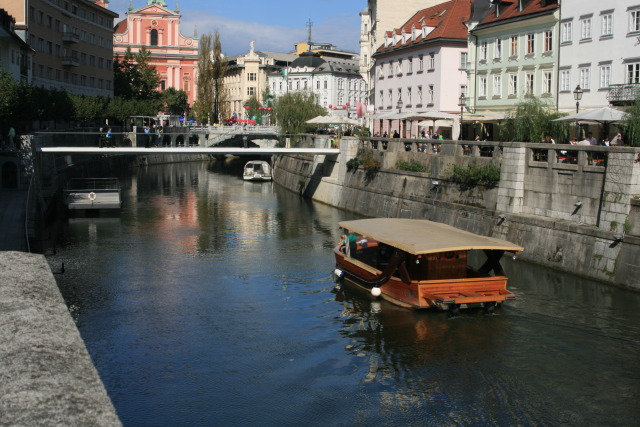By Pamela Hunt
When visiting a city that is up and coming in the tourist world, I expect to see the unfortunate trapping of newfound popularity—souvenir shops brimming with cheap knickknacks, exhaust fumes pouring from innumerable buses, and tossed-away wrappers fluttering down sideways like leftover parade confetti. In narrow cobblestone streets weaving through the Art Deco and Baroque architecture of Ljubljana, Slovenia, however, I discovered that things couldn’t more different.
Ranked second in Lonely Planet’s 2014 list of Europe’s best places to visit, this cozy capital city offers visitors plenty of opportunities to sightsee, indulge in the fusion of Austrian and Mediterranean cuisine, and revel in the melding of its surrounding cultures, paving the way for an environmentally sound and sustainable future.
In June 2014, the European Commission presented Ljubljana with the European Green Capital award for 2016. The award was created in 2006 to commend cities in Europe that are making efforts to improve the environmental aspects of urban living. Ljubljana’s “Vision 2025” plan, which spells out the city’s goals of connecting the city with its landscape, protecting natural areas, and transforming transportation inside the city, impressed the jury.
I came upon the first of many signs that this former Yugoslavian nation is greening up as I climbed aboard the city-center-bound bus, adorned with signage proudly proclaiming it to be a biofueled vehicle. Buses represent a vital method of commuting around town for many people in Ljubljana, but choking clouds of diesel exhaust aren’t part of this city. Building the fleet gradually over the past decade, the city government now proudly supports 36 biofuel-run buses, making up 17 percent of its vehicles.
As I rode the two-and-a-half miles to the Old Town, I saw numerous cyclists pedaling along both sides of the street. In this centuries-old city between the Danube and the Adriatic, bicycles are the vehicle of choice for young and old alike, thanks to the high cost of gasoline and the relatively flat landscape. Bicekelj , a self-service bike rental system, launched in May 2011 with 300 bicycles that users can pick up at one location and drop off at another. Since then, the company has grown from thirty-one to thirty-six stations throughout the city, with more than two million rides logged in three years. Though many of the rides are short, approximately 10 percent of Ljubljana’s residents have used the system, with 25,000 opting for the annual membership. And there’s no need to ride in traffic—the roads and sidewalks feature wide, well-marked bike lanes. The city has improved and expanded the bicycle path system, including a new path in the grand Tivoli Park, which provides a shorter route from the north to the south parts of the city.
To familiarize myself with Old Town Ljubljana and its history, I joined a free city tour in the main square, Prešernov Trg. Our guide, Tine, explained that starting in 2013, Ljubljana began cutting off access to motorized traffic inside the city center, prioritizing pedestrians, bicyclists, and public transportation. Though I still found myself elbowing my way through the crowds of camera-toting tourists on the Tromostovje, or Triple Bridge, I was reassured that a speeding car wouldn’t barrel down on me while I was enjoying the architecture.
The pedestrian-only areas don’t preclude accommodations for those needing assistance getting around. Three electric vehicles, known as Cavaliers, patrol the old town, stopping for those who need a ride from site to site on the sightseeing circuit. Passengers can either flag down the vehicles on the fly, or they can call for a pickup in advance. The service is free and runs year round from 8 a.m. until 8 p.m.
And the lack of litter in the streets? This cleanliness is achieved thanks to the numerous collection sites scattered throughout the city. These eco-islands provide simple yet attractive bins for the disposal of paper products, recyclable plastics, glass, food waste, and straight-out garbage. Though these metal bins are a welcome change from small, overflowing public garbage cans—of lack of—I have seen in other cities, Ljubljana is going one step further. Since 2008, the city has been moving these public waste sites underground to improve the visual beauty of the area.
Following the promenade along the Ljubljanica River, I turned to cross the arched Zmajski Most, the bridge guarded on both ends by massive green dragons, the protective symbol of the city. Perhaps the color of these beasts represents the direction Ljubljana has taken in its rebirth from a medieval trade center to a modern city.
About the author
Pamela Hunt is a freelance writer and editor, curious traveler, and amateur foodie living Burlington, Vermont. She has explored her wanderlust and appetite, as well as general Vermont goings-on, in Best of Burlington, Destination VT, and Edible Green Mountains.



